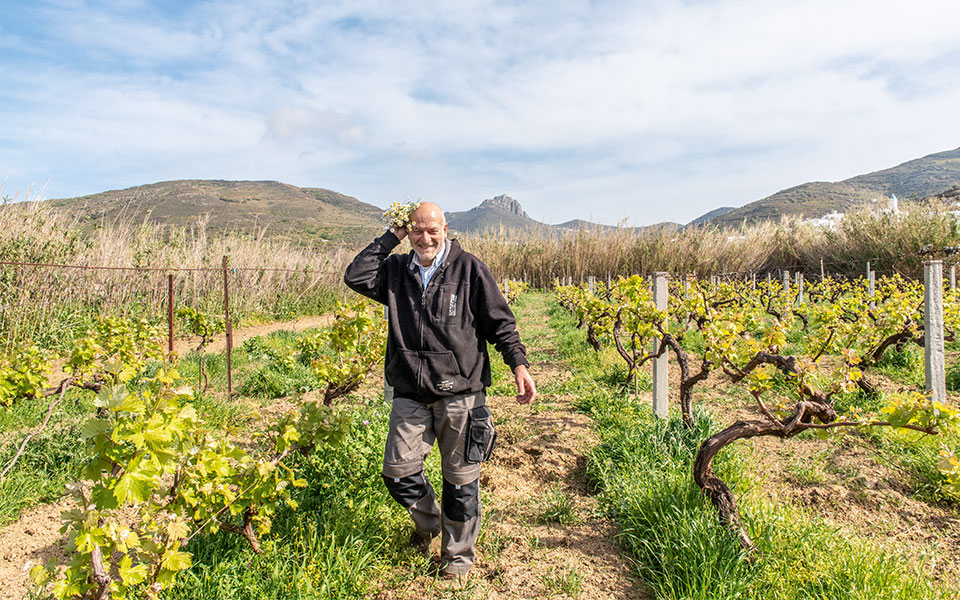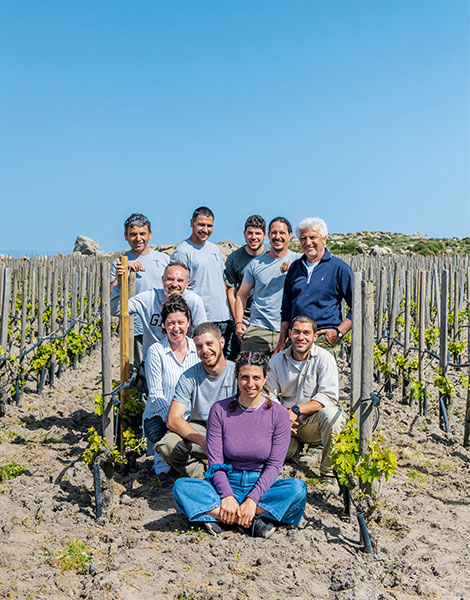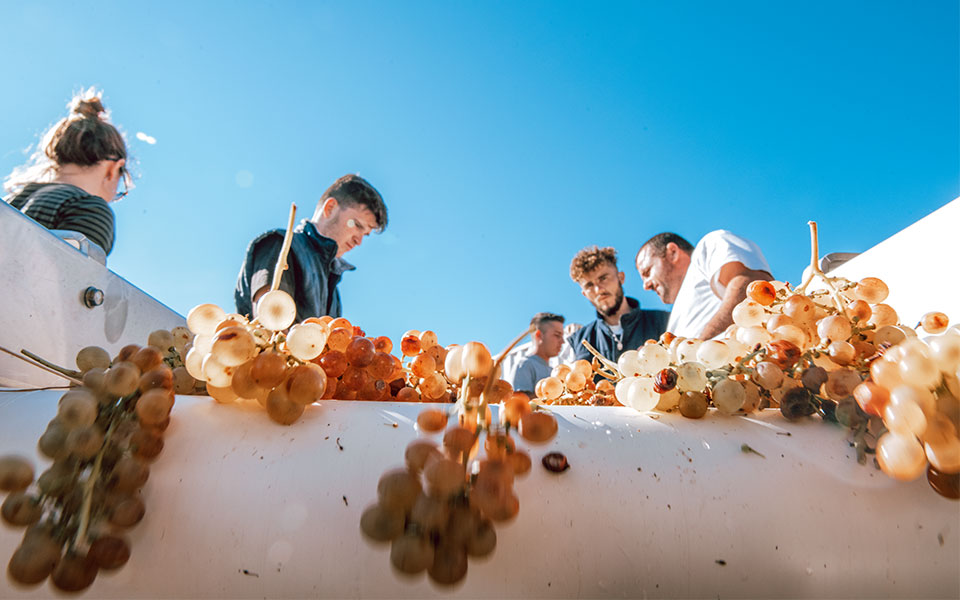Tinos boasts a wine-making tradition that dates back centuries, but the once exceptionally thriving vines of the island have faded over the years. Scattered among the vines, however, remain a few structures on the terraced slopes, small household wineries called “kathikies,” still reminiscent of those times. The idea to revive the island’s small yet historic vineyards lies with a handful of “crazy” visionaries, who envisioned a future and potential in this rare terroir, with its arid soils and local varieties.
As such, in recent years, with the revival of the cultivation of own-rooting native varieties such as Potamisi and Koumariano, from vineyards dating back more than 50 years, as well as with new plantings of other Cycladic and Greek varieties, such as Assyrtiko, Mavrotragano and Malagouzia, the wine-making profile of Tinos is blooming once more. Working systematically to become one of the most important wine regions in the country, Tinos has all the assets: the sweetness of the sun and the salinity of the sea give birth to all types of wines – rustic, modern and minimal intervention.

© Evelyn Foskolou
Veteran and emerging winemakers
In his “white vineyard,” leading the revival is winemaker Christos Fonsos, who came before the others and has been persistently cultivating traditional, non-commercial varieties from which the Tinos Marathoraki wine is produced. This seasoned winemaker, a keen proponent of local varieties such as Potamisi, Monemvasia and Koumariano, has been producing unique wines in a small winery in Komi since 1997. In fact, he made his first exports to New York just recently. “These are not poolside wines. They are not friendly; you have to trust them to reveal their truth,” he says. It is worth coming to this gorgeous village to meet him and let him give you a tour around his self-rooting vineyard (by appointment at Tel. (+30) 697.766.8060).
Chronologically, Fonsos was followed by the T-Oinos Winery and Vineyards established by Alexandros Avatagelos. The first harvest took place in 2008 in a small winery equipped with state-of-the-art technology. However, their most significant investment is not the equipment or machinery, but their selected and experienced collaborators, such as French wine consultant Stéphane Derenoncourt and the chef sommelier and wine director of Alain Ducasse’s restaurants, Gerard Margeon. Just as important is the creation of their exemplary vineyard in the mountainous Falatados area, the island’s prime viticultural zone.
There, in extreme weather conditions and among giant boulders, they have planted Assyrtiko, Malagouzia, Mavrotragano and Avgoustiatis varieties. From these vines they produce some of the most premium Greek wines, such as two single-varietal Clos Stegasta Rare wines made from Mavrotragano and Assyrtiko, which retail for around €130. It is worth tasting them in a unique wine tasting experience guided by wine expert, Panagiota Kalogeropoulou (Aghios Dimitrios, Falatados, Tel. (+30) 22830.411.20, visits by appointment).

© Evelyn Foskolou

© Evelyn Foskolou
In this same area, since 2010, you can also find the organic vineyards of Volacus Wine, owned by Michalis Kontizas. Located in the area of Gargaris or Kardari in Falatados, amidst towering granite rocks, you will explore a fascinating landscape with Malagousia, Assyrtiko and Mavrotragano planted on terraces (visits by appointment, Τel. (+30) 697.848.5671). There, within the vineyard, under the plane tree and next to the old residence, you will have the opportunity to try their wines, produced in Fonsos’ winery. Do not leave before sunset, as the setting is idyllic.
Before leaving, you must also definitely visit the beautiful, traditional village of Falatados, located very close to Steni and the next wine destination, the Vaptistis Winery. The owner, Giannis Moraitis, started making wines for the first time in 2016 under the guidance of oenologist Ilia Roussakis, sending his grapes to Santorini, while in 2018 he set up his own winery with enchanting views over Mount Tsiknias and Mykonos. Before the wine tasting, take a walk through the vineyard among the young Assyrtiko and Mavrotheriko vines, in front of a restored dovecote. They recently acquired an old, precious vineyard with 50-year-old Potamisi vines, which translates into an exceptionally interesting wine that is worth trying, among others (visits by appointment, Τel. (+30) 697.797.9627).
Just a three-minute drive away from the Moraitis winery you will find the Winery Domaine de Kalathas, where French graphic designer and antiques dealer Jerome Binda produces quirky, experimental wines with minimal intervention and minimal use of sulfites. The gamble has started to pay off, using grapes from 150-year-old vineyards such as local Potamisia and Koumariano grapes, while from the newly-planted Assyrtiko, Mavrotheriko and Mandilaria vines he produces interesting selections. The Sainte-Obéissance (Vignes Centenaires), a blend of white Potamisi and table Rosaki, is his pride and joy (visits by appointment, contact Tel. (+30) 33 652371771).

© Evelyn Foskolou
The future is bright
In the island’s restaurants one can also try the exceptional, small-production X-Bourgo wines. Civil engineer Theodoros Kosmopoulos moved mountains to plant Assyrtiko, Mavrotragano and Mavrotheriko on terraces in the villages of Tripotamos and Kalloni, in carefully cultivated vineyards that are nurtured like babies. By investing in orchards, this romantic wine maker aims to “create memory”. Even though there are plans to establish a winery, for the time being the grapes are transported and vinified in a winery in Attica. Lastly, one more winery is in the works, owned by the Papageorgiou family, near Xinara and underneath Exobourgo. Their vineyard, stretching over 30 acres, is planted with Potamisi, Rozaki, Koumariano, Assyrtiko and Mavrotragano vines, while its bioclimatic winery nestled in the landscape is equipped with a cluster of concrete tanks shaped like tulips. These will be used for the first time this summer by oenologist Eleni Alevra, with the aim of producing terroir wines.
The vineyards of Tinos attract those with the foresight to see its dynamic potential, while its rapid development and revival has sparked the interest of international media, such as journalist Rachel Howard, who characteristically mentions in an article published by The Guardian: “This windswept landscape is Greece’s new wine frontier.” This wine producing-land is unique, and wandering through its vineyards is an experience not to be missed.












